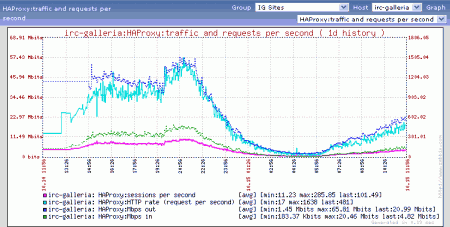Script and template to export data from haproxy to zabbix
I’ve just created a zabbix template with a script which can be used to feed performance data from haproxy to zabbix. The script firsts uses HTTP to get the /haproxy?stats;csv page, parses the CSV and uses zabbix_sender command line tool to send each attribute to the zabbix server. The script can be executed on any machine which can access both zabbix server and the haproxy stats page (I use the machine which runs the zabbix_server). The script and template works on both zabbix 1.6.x and 1.8.x.
As the haproxy server names might differ from zabbix server names, the script uses annotations inside the haproxy.cfg hidden in comments. The annotations tell the script which frontend and server node statistics should be sent to the zabbix server. This allows you to keep the configuration in a central place which helps keeping the haproxy and zabbix configurations in sync. The template includes two graphs, example below:
I’ve chosen to export following attributes from haproxy, but more could be easily added (I accept patches via github.com):
- Current session count
- Maximum session count
- Sessions per second
- HTTP responses per minute, grouped by 1xx, 2xx, 3xx, 4xx and 5xx.
- Mbps in (network traffic)
- Mbps out (network traffic)
- Request errors per minute
- Connection errors per minute
- Response errors per minute
- Retries (warning) per minute
- Rate (sessions per second)
- HTTP Rate (requests per second)
- Proxy name in haproxy config
- Server name in haproxy config
The code is available at github: https://github.com/garo/zabbix_haproxy The script supports HTTP Basic Authentication and masking the HTTP Host-header.
Usage:
- Import the template_haproxyitems.xml into Zabbix.
- Add all your webservers to zabbix as hosts and link them with the Template_HAProxyItem
- Add all your frontends to zabbix as hosts and link them with the Template_HAProxyItem. The frontend hosts don’t need to be mapped to any actual ip nor server, I use the zabbix_server ip as the host ip for these.
- Edit your haproxy.cfg file and add annotations for the zabbix_haproxy script. These annotations mark which frontends and which servers you map into zabbix hosts. Notice that the annotations are just comments after #, so haproxy ignores them.
frontend irc-galleria # @zabbix_frontend(irc-galleria) bind 212.226.93.89:80 default_backend lighttpd backend lighttpd mode http server samba 10.0.0.1:80 check weight 16 maxconn 200 # @zabbix_server(samba.web.pri) server bossanova 10.0.0.2:80 check weight 16 maxconn 200 # @zabbix_server(bossanova.web.pri) server fuusio 10.0.0.3:80 check weight 4 maxconn 200 # @zabbix_server(fuusio.web.pri) - Setup a crontab entry to execute the zabbix_haproxy script every minute. I use the following entry in /etc/crontab:
*/1 * * * * nobody zabbix_haproxy -c /etc/haproxy.cfg -u "http://irc-galleria.net/haproxy?stats;csv" -C foo:bar -s [ip of my zabbix server]
- All set! Go and check the latests data in zabbix to see if you got the values. If you have problems you can use -v and -d command line arguments to print debugging information.
